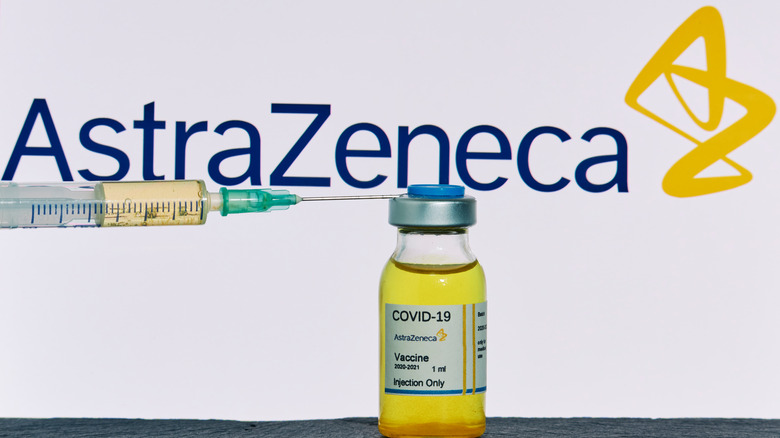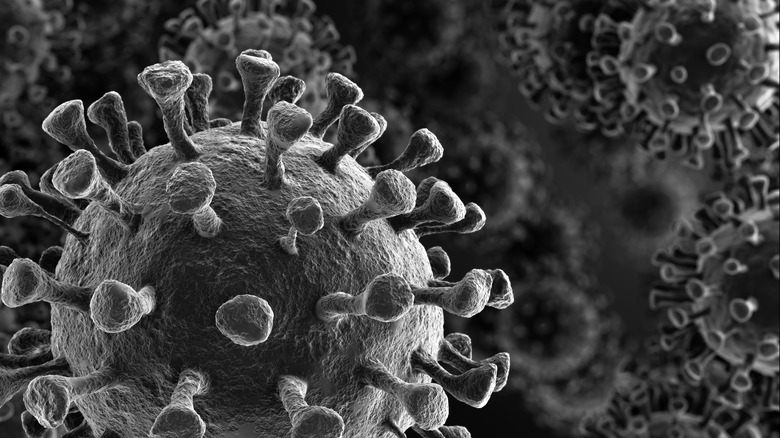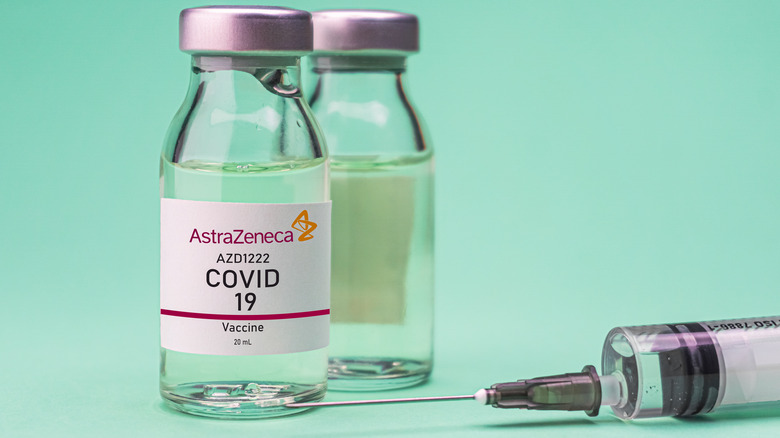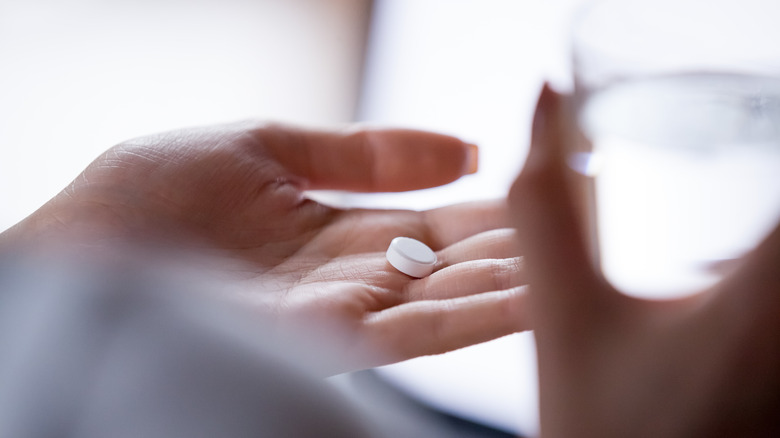If You Get The AstraZeneca COVID Vaccine, This Happens To Your Body
At the height of the pandemic, it felt like we would never find a way back to the normal everyday life we once had. Governments and companies around the world poured money into vaccine research, the only viable option for those looking to safely end lockdowns. And then, after almost a year, the first vaccines became available for emergency use in December 2020. This vaccine belonged to Pfizer who produced it while working with BioNTech.
Close on Pfizer's heels, according to a BBC article from that month, was AstraZeneca. Also known as the Oxford vaccine, it quickly gained favor in the UK because, as the BBC put it, the vaccine was made in the UK. This meant reduced shipping times and more readily available doses for the local population.
Less than four months later, however, many countries were suspending use of the vaccine. Numerous cases of odd blood clots were reported, all associated with AstraZeneca. These concerns made people wonder how the vaccine worked, what happened when it hit the body, and why some people seemed to develop blood clots while others were fine.
Scientists are still looking into the specific mechanics that cause the blood clots, but the rest of the questions have already been answered. It all comes down to the way the vaccine interacts with our bodies and the other substances we put in them.
How the vaccine is made
The first thing most people want to know about vaccines is how they work. On the surface it seems odd that we can take part of a deadly virus, break it up, put it into a shot, and wind up protected from that same disease. But when you look at the mechanics of how a vaccine is created and how our bodies respond to it, the process makes a lot more sense.
By now, most people have seen the general shape of a coronavirus. It looks sort of like an orange pomander, the aromatic holiday decoration made by pushing whole cloves into an orange. And it is this shape that gives them their name. As Healthline explains, COVID-19 viruses have "crown-like protrusions" on their surface. Corona is Latin for crown, so coronavirus translates roughly to "crown virus."
But there is nothing regal about those crowns. According to Science Based Medicine, they are known as protein spikes. And they are the bit of the virus that digs into our cells and allows for infection. As the BBC explains, however, they are also the key to making the AstraZeneca vaccine.
Researchers cut the protein spikes off a coronavirus and then added those spikes to a harmless virus. This harmless secondary virus acts as a carrier, sort of like a carrier oil allows for the use of essential oils that would otherwise agitate a person's skin. The harmless virus gets the spike proteins into our bodies without causing a real COVID-19 infection.
Our immune response to the vaccine
When someone receives their vaccine, they are injected with this harmless carrier virus as well as the protein spikes. This forces the body to react. According to the BBC, this means that our immune system activates, creating antibodies and T cells to fight the protein spikes as they try to latch onto our cells. And since the protein spikes are not attached to the large body of a coronavirus, our bodies have an easier time fighting them.
This fight is also why many people develop mild symptoms after receiving their vaccine. The Mayo Clinic explains that many vaccine side effects feel similar to colds and flus because in all three cases, the immune system is the culprit, not the vaccine or the disease. When you receive a vaccine (or catch a cold), the discomfort you generally feel isn't the disease attacking you, it's your body fighting back.
The clinic also explains that this is why sometimes a second dose can make you feel worse than the first dose. Melanie Swift, M.D., MPH is the co-chair of the Mayo Clinic's COVID-19 Vaccine Allocation and Distribution Work Group and she says that the first vaccine dose is akin to helping your body study for the test. It encounters the spike proteins and learns how to best fight them. When you receive your second dose, your body treats it like the big test and it's going for an A. It's primed for a fight so the reactions are more severe.
AstraZeneca symptoms
Of course, side effects and their severity seem to vary from person to person — and for the same reasons that some people can shrug off a cold while others can barely get out of bed to find a fresh box of tissues. Each body has its own way of dealing with infection. When people do experience side effects, however, they tend to follow a certain pattern.
When it came to the AstraZeneca vaccine, the government of Queensland, Australia wanted to be prepared. They released an informative PDF listing the common side effects of the vaccine, as well as slightly less common side effects and a general time table explaining how long the symptoms should last. According to that document, the AstraZeneca vaccine could cause headache and chills or fever, tiredness, a feeling of being generally unwell, nausea, and joint or muscle pain. The injection site could also be red, swollen, hot, or itchy.
Slightly less common side effects include a diminished appetite, swollen lymph nodes, limb pain, dizziness, and stomach pain or GI distress. In all cases, the symptoms should clear up in a matter of days. It is only when the symptoms linger beyond that time frame that the Australian government urges people to seek additional medical care. The good news is that these symptoms are on par with the other major vaccines, according to the Centers for Disease Control and Prevention (CDC). But that doesn't address the larger concern over blood clots.
The clotting concern with the AstraZeneca vaccine
One of the most important things to know about the AstraZeneca blood clots is that, even in the groups at higher risk for them, they're rare. The BBC states that people over 40 have a 1 in 100,000 chance of developing blood clots from the vaccine. That risk increases to one in only 60,000 for people in their 30s and under which still makes them unlikely but is a much higher risk level than the risk to older people.
Cosmos, the space and technology magazine, puts the numbers another way. As of April 2021, there had been 168 cases of blood clots out of 21.2 million administered doses of AstraZeneca. This works out to roughly 8 cases per every one million doses. For comparison, the same kind of clots happen to five out of every million people per year without the vaccine's interference. So the vaccine does cause an increase, but not a large one.
These numbers are related to a specific type of clot, however. The clots that halted AstraZeneca production are known as Cerebral Venous Sinus Thrombosis or CVST. These are stationary clots that form in the large veins of the head. Johns Hopkins Medicine explains that when this happens it prevents blood from draining out of the brain properly. When the buildup becomes too great, the blood leaks into the brain tissue and can cause a stroke or death. So while the vaccine causes only a marginal risk increase, the potential fallout is devastating.
Blood clot risk factors
Scientists are still trying to narrow down why some people develop the clots while others don't. But there is one link that many researchers are pinning their attention on. As the Daily Mail reported in March, oral contraception and smoking can possibly raise a person's risk of developing vaccine-related blood clots. Their article stated the medical regulators in Europe were looking at a connection between either risk factor and the vaccine, trying to determine a reason why cases happen mostly to women and those under the age of forty to fifty.
Smoking is known to increase a person's risk of developing blood clots. According to the American Blood Clot Association, some of the roughly 600 ingredients in cigarettes change the surface of blood platelets, which makes them more likely to pile up and form clots.
Unfortunately, the connection between birth control and blood clots is not as well-known, despite the 19,000 lawsuits against Bayer between 2009 and 2019 for their Yaz (also known as Yasmine) birth control (via DrugWatch). The lawsuits alleged that the oral contraceptive causes clots, heart attack, and stroke, namely strokes brought on by CVST after the drug was found to greatly increase the risks, landing women in the hospital and, in some cases, killing them.
But Yaz is not the only contraceptive that can cause blood clots. Taking any oral contraceptive makes a woman 7.59 times more likely to develop clots according to a 2015 review published in the journal Frontiers of Neurology.
Birth control and blood clots
Researchers are still looking into the link between birth control and an increased risk of clotting after an AstraZeneca dose. Early numbers showed that women were far more likely than men to develop clots but, as Cosmos points out, the first blood clot cases were from the first to be vaccinated. These were largely healthcare workers and the nursing profession is a female-dominated field.
However the possible link between birth control and the AstraZeneca clots cannot be ignored. As the National Women's Health Network explains, an increased level of estrogen makes it easier for blood to clot. There are oral contraceptives that do not increase estrogen levels that, according to the network, may be more effective than those that do. They make a good option for those who worry about the increased risk of clots.
This connection may seem like a stretch to some, but in countries where AstraZeneca is still used, they do not want to take any chances. This is because a CVST often doesn't present symptoms. Johns Hopkins Medicine explains that similar clots elsewhere in the body can lead to pain at the clot site, swelling or redness of the area, a sudden change in mental state, and going numb or weak on one side of the body. With CVSTs, however, symptoms may only include a headache, light-headedness, or anxiety.
Hope for a treatment
While some scientists are working on finding the cause of these clots and their possible link to risk factors like smoking or taking birth control, other researchers are looking at ways to treat the clots once they form. Just today, the Sydney Morning Herald announced that the fatality rate of CVST and the more generalized form known as thrombosis with thrombocytopenia (TTS) is dropping.
The Herald reports that the fatality rate of TTS used to be one in four. But that is changing. Late last week, Australia had 31 confirmed TTS cases and 10 possible cases. 23 of those patients are now recovering at home, four require continued care, and 13 are still hospitalized.
Most of this improvement is due to better screening. This gives doctors more time to administer treatments, of which there are four main types according to the CDC. The first is Heparin, an anticoagulant that helps break up blood clots and prevent others from forming. Barring this, patients may be given a nonheparin anticoagulant. They may also receive platelet transfusions as TTS is marked by low levels of platelets in the blood. Patients may also be treated with immunoglobulin usually administered by IV directly to the patient's bloodstream.
Current vaccination rates
According to Breaking News, which operates out of Ireland, AstraZeneca is currently in use throughout most of Europe, but some countries have restrictions placed on who can receive the vaccine. These restrictions generally limit it to those over the age of 40, though some countries have even increased that age to 55 or even 60.
In all cases, the goal is to make sure there are enough vaccines for everyone and to get as many people vaccinated as possible. CNN reports that, globally, we are almost administering 35 million doses of vaccines per day. Gibraltar currently leads the world in vaccine distribution with roughly 2.3 doses administered for 100 people, accounting for the two doses needed for most vaccines to be fully effective.
But we still have a long way to go. The CDC offers a forecast on their predictions for the number of nationwide COVID deaths, based on vaccination numbers and other precautionary measures. Their lowest forecast still predicts over 2,000 COVID deaths in the last week of July 2021. That's a much more hopeful number than the 20,000 confirmed deaths recorded in late January of 2021, but it is still a number that can be reduced with continued care and vaccination.
Looking ahead to the future
In April, CNN reported that government advisors in America stated they would likely never approve AstraZeneca for use in the United States. This follows suit with our continental neighbors, as Mexico has also refused to approve the vaccine while Canada only offers it to people 55 and over after a risk analysis. Advisors in the United States, however, said that there was no reason to approve AstraZeneca when there were so many other options.
More importantly, they said, the risks associated with AstraZeneca could increase vaccine hesitancy. While global daily vaccine doses are around 35 million, daily doses in America have dropped to a little under a million a day, according to NPR. Almost 42% of Americans have been vaccinated, which is just over half of the vaccination level needed to stop the spread of COVID-19.
The rate of vaccination may hold steady as vaccines are cleared for use on people in younger demographics, but adults will have to continue getting vaccinated in order to reach the 70-85% vaccination level needed to protect the country against another surge of cases and deaths.










